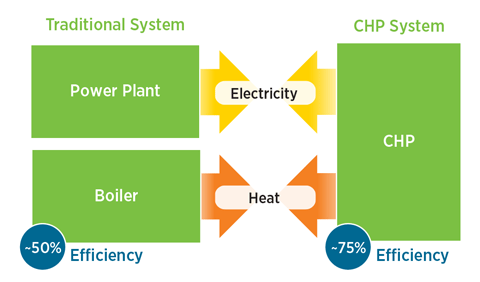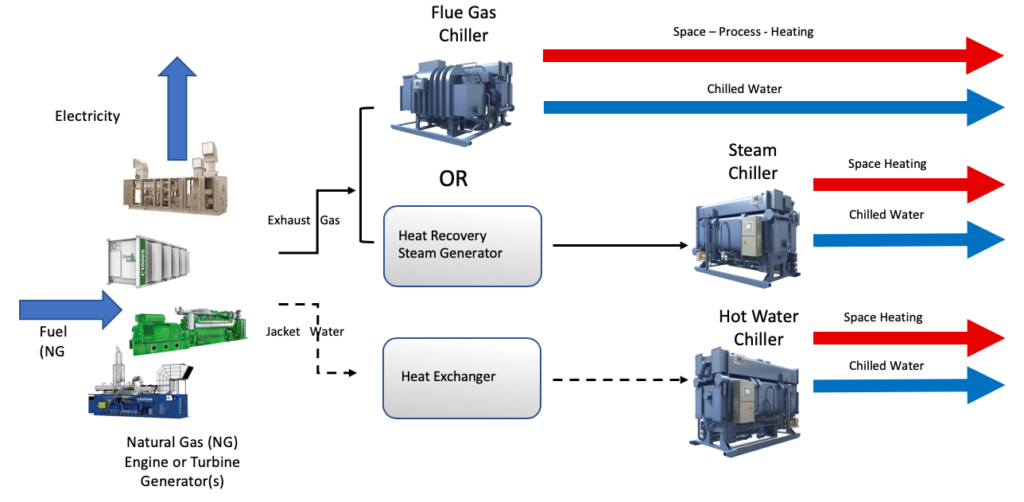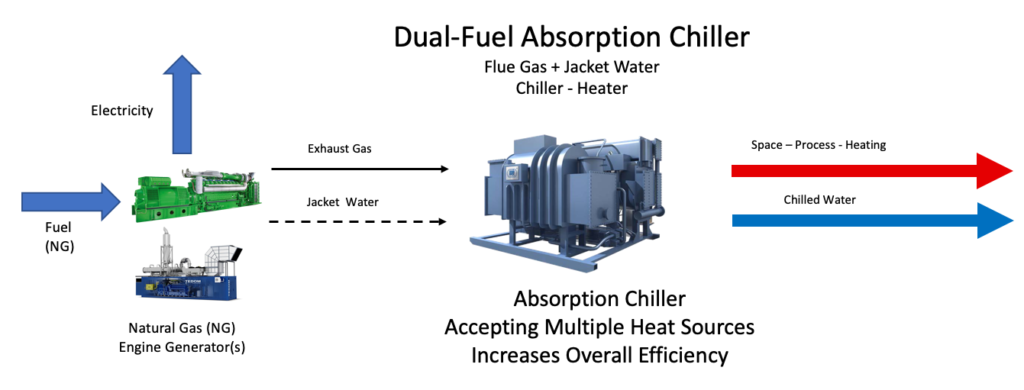Combined Cooling Heating and Power (CCHP)
Combined heat and power (CHP), also known as co-generation, is:
CHP Process Flow Diagram The concurrent production of electricity or mechanical power and useful thermal energy (heating and/or cooling) from a single source of energy.
Combined Cooling Heating & Power (CCHP) refers to CHP, where cooling is also included.
A type of distributed generation, which, unlike central station generation, is located at or near the point of consumption.
A suite of technologies that can use a variety of fuels to generate electricity or power at the point of use, allowing the heat that would usually be lost in the power generation process to be recovered to provide needed heating and/or cooling.
(Source: Department of Energy “Combined Heat & Power Deployment” http://energy.gov/eere/amo/combined-heat-and-power-basics)

SHUANGLIANG ECO-ENERGY CCHP WASTE HEAT RECOVERY ABSORPTION CHILLER SOLUTIONS



CHP Technology
CHP technology can be deployed quickly, cost-effectively, and with few geographic limitations. CHP can use a variety of fuels, both fossil- and renewable-based. It has been employed for many years, mostly in industrial, large commercial, and institutional applications.
CHP may not be widely recognized outside industrial, commercial, institutional, and utility circles, but it has quietly been providing highly efficient electricity and process heat to some of the most vital industries, largest employers, urban centers, and campuses in the United States.
It is reasonable to expect CHP applications to operate at 65-90% efficiency, a large improvement over the national average of ~50% for these services when separately provided.
The US Department of Energy (DOE) Advanced Manufacturing Office’s provides stakeholders with the resources necessary to identify CHP market opportunities and support the implementation of CHP systems in industrial, federal, commercial, institutional, and other applications.

Combined heat and power (CHP)
Combined heat and power (CHP) positively impacts the health of local economies and supports national policy goals in several ways. Specifically, CHP can:
Improve Energy Efficiency
Improve energy efficiency by capturing heat that is normally wasted.
In 2006, the US emitted 5,890 million metric tons (MMT) of carbon dioxide. This number is projected to rise to 6,851 MMT of carbon dioxide in 2030. If CHP were to supply 20% of US electricity generating capacity by 2030, the projected increases in carbon dioxide emissions would be cut by 60%.
Through continued research, development, and outreach, DOE and its partners could help to increase CHP’s share of US electricity generating capacity dramatically. Recognizing the benefits of CHP and its current underutilization as an energy resource in the United States, the Obama Administration has a goal to achieve 40 gigawatts (GW) of new, cost-effective CHP by 2020. As discussed in the August 2012 DOE and EPA report, Combined Heat and Power: A Clean Energy Solution, achieving this goal would:
Combined Heat and Power
An Energy-Efficient Choice for Mid-Size to Large Hotels
Combined heat and power (CHP), also known as co-generation, can be an excellent solution for controlling energy costs while improving the reliability of power supply for your hotel. With CHP, your hotel can:
“CHP projects today offer compelling payback in under four years with good thermal integration and product matching to customer energy use. Depending on potential subsidiary benefits, e.g., back-up power, financial offsets to utility service upgrades for expansion, power quality, incentives, etc., IRRs of above 30% can be achieved.
Project costs range from a couple hundred thousand dollars to a couple of million dollars, depending on Hotel size, annual occupancy, thermal uses for a turnkey solution.
Strategic benefits include sound financial savings over conventional services, protection from blackouts, improved reliability with independence from the grid, and a reduced carbon footprint.” – Murray Millander – Founder, Distributed Energy Solutions, Inc.
Is My Hotel a Good Fit for CHP?
If you answered “yes” to three or more of these questions, your hotel might be a good candidate for CHP.
Note: Much of the source content directly from EPA Combined Heat & Power Partnership web site: http://www.epa.gov/chp/markets/hotel_fs.html

 Hotels with 100 to 300 rooms: Could utilize a 60 to 250 kilowatt (kW) CHP system based on reciprocating engines, microturbines, or fuel cells, which would supply hot water for customers, space heating, and laundry needs.
Hotels with 100 to 300 rooms: Could utilize a 60 to 250 kilowatt (kW) CHP system based on reciprocating engines, microturbines, or fuel cells, which would supply hot water for customers, space heating, and laundry needs. Resort hotels and casinos with more than 500 rooms can utilize CHP systems of 1 to 20 megawatts (MW) run by reciprocating engines or gas turbines. These systems can provide all of the facility’s heating and cooling needs, in addition to a large portion of the electricity loads. They can be configured to operate in the event of a utility outage.
Resort hotels and casinos with more than 500 rooms can utilize CHP systems of 1 to 20 megawatts (MW) run by reciprocating engines or gas turbines. These systems can provide all of the facility’s heating and cooling needs, in addition to a large portion of the electricity loads. They can be configured to operate in the event of a utility outage.